Impact of a Novel PagR-like Transcriptional Regulator on Cereulide Toxin Synthesis in Emetic Bacillus cereus
Abstract
:1. Introduction
2. Results and Discussion
2.1. Identification of PagR-like ArsR/SmtB Family Regulators on the pCER270 Plasmid
2.2. In Vitro Binding of PagR Homologues to the ces Promoter Region
2.3. Interactions of PagR Homologues Identified by a Bacterial Two-Hybrid Assay
2.4. Phenotypic Characterization of a pagRBc Gene-Deletion Mutant
2.5. PagRBc Acts as a Repressor of Cereulide Synthetase Gene Expression
3. Materials and Methods
3.1. Bacterial Strains and Culture Conditions
3.2. General Molecular Methods
3.3. Construction of E. coli Protein Expression Strains for Electrophoretic Mobility-Shift Assay (EMSA)
3.4. Production and Purification of Heterologous Proteins PagRBc-His6, PagR1-His6 of Emetic B. cereus and PagR-His6 of B. anthracis
3.5. Gel Mobility Shift Assay
3.6. Bacterial Two-Hybrid System (BACTH) and β-Galactosidase Assay
3.7. Construction of the B. cereus pagRBc Null Mutant Strain F48ΔpagR
3.8. Expression of pagR Homologues in the pagRBc Null Mutant F48ΔpagR
3.9. Transcriptional Analysis of cesB Expression by qRT-PCR
3.10. Cereulide Quantification by Means of Ultraperformance Liquid Chromatography (UPLC) Tandem Mass Spectrometry (MS/MS)
3.11. Sequence Analysis
4. Conclusions
Supplementary Materials
Author Contributions
Funding
Institutional Review Board Statement
Informed Consent Statement
Data Availability Statement
Acknowledgments
Conflicts of Interest
References
- Dietrich, R.; Jeßberger, N.; Ehling-Schulz, M.; Märtlbauer, E.; Granum, P.E. The food poisoning toxins of Bacillus cereus. Toxins 2021, 13, 98. [Google Scholar] [CrossRef] [PubMed]
- Ehling-Schulz, M.; Koehler, T.M.; Lereclus, D. The Bacillus cereus group: Bacillus species with pathogenic potential. Microbiol. Spectr. 2019, 7, 6. [Google Scholar] [CrossRef] [PubMed]
- Messelhäußer, U.; Ehling-Schulz, M. Bacillus cereus–A Multifaceted Opportunistic Pathogen. Curr. Clin. Microbiol. Rep. 2018, 5, 120–125. [Google Scholar] [CrossRef]
- Bottone, E.J. Bacillus cereus, a volatile human pathogen. Clin. Microbiol. Rev. 2010, 23, 382–398. [Google Scholar] [CrossRef] [PubMed]
- Drobniewski, F.A. Bacillus cereus and related species. Clin. Microbiol. Rev. 1993, 6, 324–338. [Google Scholar] [CrossRef]
- Ehling-Schulz, M.; Guinebretiere, M.H.; Monthán, A.; Berge, O.; Fricker, M.; Svensson, B. Toxin gene profiling of enterotoxic and emetic Bacillus cereus. FEMS Microbiol. Lett. 2006, 260, 232–240. [Google Scholar] [CrossRef]
- Rasko, D.A.; Rosovitz, M.J.; Økstad, O.A.; Fouts, D.E.; Jiang, L.; Cer, R.Z.; Kolstø, A.B.; Gill, S.R.; Ravel, J. Complete sequence analysis of novel plasmids from emetic and periodontal Bacillus cereus isolates reveals a common evolutionary history among the B. cereus-group plasmids, including Bacillus anthracis pXO1. J. Bacteriol. 2007, 189, 52–64. [Google Scholar] [CrossRef]
- Baillie, L.; Read, T.D. Bacillus anthracis, a bug with attitude! Curr. Opin. Microbiol. 2001, 4, 78–81. [Google Scholar] [CrossRef]
- Koehler, T.M. Bacillus anthracis genetics and virulence gene regulation. In Anthrax; Springer: Berlin, Germany, 2002; pp. 143–164. [Google Scholar]
- Perego, M.; Hoch, J.A. Commingling regulatory systems following acquisition of virulence plasmids by Bacillus anthracis. Trends Microbiol. 2008, 16, 215–221. [Google Scholar] [CrossRef]
- Fouet, A. AtxA, a Bacillus anthracis global virulence regulator. Res. Microbiol. 2010, 161, 735–742. [Google Scholar] [CrossRef]
- Dale, J.L.; Raynor, M.J.; Ty, M.C.; Hadjifrangiskou, M.; Koehler, T.M. A dual role for the Bacillus anthracis master virulence regulator AtxA: Control of sporulation and anthrax toxin production. Front. Microbiol. 2018, 9, 482. [Google Scholar] [CrossRef] [PubMed]
- McCall, R.M.; Sievers, M.E.; Fattah, R.; Ghirlando, R.; Pomerantsev, A.P.; Leppla, S.H. Bacillus anthracis virulence regulator AtxA binds specifically to the pagA promoter region. J. Bacteriol. 2019, 201, e00569-19. [Google Scholar] [CrossRef] [PubMed]
- Dai, Z.; Sirard, J.; Mock, M.; Koehler, T.M. The atxA gene product activates transcription of the anthrax toxin genes and is essential for virulence. Mol. Microbiol. 1995, 16, 1171–1181. [Google Scholar] [CrossRef] [PubMed]
- Mignot, T.; Mock, M.; Fouet, A. A plasmid-encoded regulator couples the synthesis of toxins and surface structures in Bacillus anthracis. Mol. Microbiol. 2003, 47, 917–927. [Google Scholar] [CrossRef] [PubMed]
- Hoffmaster, A.R.; Koehler, T.M. Autogenous regulation of the Bacillus anthracis pag operon. J. Bacteriol. 1999, 181, 4485–4492. [Google Scholar] [CrossRef]
- Dommel, M.K.; Frenzel, E.; Strasser, B.; Blöchinger, C.; Scherer, S.; Ehling-Schulz, M. Identification of the main promoter directing cereulide biosynthesis in emetic Bacillus cereus and its application for real-time monitoring of ces gene expression in foods. Appl. Environ. Microbiol. 2010, 76, 1232–1240. [Google Scholar] [CrossRef]
- Magarvey, N.A.; Ehling-Schulz, M.; Walsh, C.T. Characterization of the cereulide NRPS alpha-hydroxy acid specifying modules: Activation of alpha-keto acids and chiral reduction on the assembly line. J. Am. Chem. Soc. 2006, 128, 10698–10699. [Google Scholar] [CrossRef]
- Ehling-Schulz, M.; Vukov, N.; Schulz, A.; Shaheen, R.; Andersson, M.; Märtlbauer, E.; Scherer, S.; Shaheen, R.; Scherer, S. Identification and Partial Characterization of the Nonribosomal Peptide Synthetase Gene Responsible for Cereulide Production in Emetic Bacillus cereus. Appl. Environ. Microbiol. 2005, 71, 105–113. [Google Scholar] [CrossRef]
- Ehling-Schulz, M.; Fricker, M.; Grallert, H.; Rieck, P.; Wagner, M.; Scherer, S. Cereulide synthetase gene cluster from emetic Bacillus cereus: Structure and location on a mega virulence plasmid related to Bacillus anthracis toxin plasmid pXO1. BMC Microbiol. 2006, 6, 20. [Google Scholar] [CrossRef]
- Gacek-Matthews, A.; Chromiková, Z.; Sulyok, M.; Lücking, G.; Barák, I.; Ehling-Schulz, M. Beyond Toxin Transport: Novel Role of ABC Transporter for Enzymatic Machinery of Cereulide NRPS Assembly Line. MBio 2020, 11, e01577-20. [Google Scholar] [CrossRef]
- Frenzel, E.; Doll, V.; Pauthner, M.; Lücking, G.; Scherer, S.; Ehling-Schulz, M. CodY orchestrates the expression of virulence determinants in emetic Bacillus cereus by impacting key regulatory circuits. Mol. Microbiol. 2012, 85, 67–88. [Google Scholar] [CrossRef] [PubMed]
- Dommel, M.K.; Lücking, G.; Scherer, S.; Ehling-Schulz, M. Transcriptional kinetic analyses of cereulide synthetase genes with respect to growth, sporulation and emetic toxin production in Bacillus cereus. Food Microbiol. 2011, 28, 284–290. [Google Scholar] [CrossRef] [PubMed]
- Ehling-Schulz, M.; Frenzel, E.; Gohar, M. Food-bacteria interplay: Pathometabolism of emetic Bacillus cereus. Front. Microbiol. 2015, 6, 704. [Google Scholar] [CrossRef] [PubMed]
- Gohar, M.; Faegri, K.; Perchat, S.; Ravnum, S.; Økstad, O.A.; Gominet, M.; Kolstø, A.B.; Lereclus, D. The PlcR virulence regulon of Bacillus cereus. PLoS ONE 2008, 3, e2793. [Google Scholar] [CrossRef] [PubMed]
- Lücking, G.; Dommel, M.K.; Scherer, S.; Fouot, A.; Ehling-Schulz, M. Cereulide synthesis in emetic Bacillus cereus is controlled by the transition state regulator AbrB, but not by the virulence regulator PlcR. Microbiology 2009, 155, 922–931. [Google Scholar] [CrossRef] [PubMed]
- Lücking, G.; Frenzel, E.; Rütschle, A.; Marxen, S.; Stark, T.D.; Hofmann, T.; Scherer, S.; Ehling-Schulz, M. Ces locus embedded proteins control the non-ribosomal synthesis of the cereulide toxin in emetic Bacillus cereus on multiple levels. Front. Microbiol. 2015, 6, 1101. [Google Scholar] [CrossRef] [PubMed]
- Ren, S.; Li, Q.; Xie, L.; Xie, J. Molecular mechanisms underlying the function diversity of ArsR family metalloregulator. Crit. Rev. Eukaryot. Gene Expr. 2017, 27, 19–35. [Google Scholar] [CrossRef]
- Busenlehner, L.S.; Pennella, M.A.; Giedroc, D.P. The SmtB/ArsR family of metalloregulatory transcriptional repressors: Structural insights into prokaryotic metal resistance. FEMS Microbiol. Rev. 2003, 27, 131–143. [Google Scholar] [CrossRef]
- Saha, R.P.; Samanta, S.; Patra, S.; Sarkar, D.; Saha, A.; Singh, M.K. Metal homeostasis in bacteria: The role of ArsR–SmtB family of transcriptional repressors in combating varying metal concentrations in the environment. Biometals 2017, 30, 459–503. [Google Scholar] [CrossRef]
- Wu, J.H.; Rosen, B.P. Regulation of the ars operon: The arsR gene product is a negative regulatory protein. Mol. Microbiol. 1991, 5, 1331–1336. [Google Scholar] [CrossRef]
- Morby, A.P.; Turner, J.S.; Huckle, J.W.; Robinson, N.J. SmtB is a metal-dependent repressor of the cyanobacterial metallothionein gene smtA: Identification of a Zn inhibited DNA-protein complex. Nucleic Acids Res. 1993, 21, 921–925. [Google Scholar] [CrossRef] [PubMed]
- Zhao, H.; Volkov, A.; Veldore, V.H.; Hoch, J.A.; Varughese, K.I. Crystal structure of the transcriptional repressor PagR of Bacillus anthracis. Microbiology 2010, 156, 385–391. [Google Scholar] [CrossRef] [PubMed]
- Gao, C.-H.; Yang, M.; He, Z.-G. An ArsR-like transcriptional factor recognizes a conserved sequence motif and positively regulates the expression of phoP in mycobacteria. Biochem. Biophys. Res. Commun. 2011, 411, 726–731. [Google Scholar] [CrossRef] [PubMed]
- Saha, R.P.; Chakrabarti, P. Molecular modeling and characterization of Vibrio cholerae transcription regulator HlyU. BMC Struct. Biol. 2006, 6, 24. [Google Scholar] [CrossRef]
- Corsi, I.D.; Koehler, T.M. Overlapping and Distinct Functions of the Paralogous PagR Regulators of Bacillus anthracis. J. Bacteriol. 2022, 204, e00208-22. [Google Scholar] [CrossRef]
- Kelley, L.A.; Mezulis, S.; Yates, C.M.; Wass, M.N.; Sternberg, M.J.E. The Phyre2 web portal for protein modeling, prediction and analysis. Nat. Protoc. 2015, 10, 845. [Google Scholar] [CrossRef]
- Endo, G.; Silver, S. CadC, the transcriptional regulatory protein of the cadmium resistance system of Staphylococcus aureus plasmid pI258. J. Bacteriol. 1995, 177, 4437–4441. [Google Scholar] [CrossRef]
- Karimova, G.; Pidoux, J.; Ullmann, A.; Ladant, D. A bacterial two-hybrid system based on a reconstituted signal transduction pathway. Proc. Natl. Acad. Sci. USA 1998, 95, 5752–5756. [Google Scholar] [CrossRef]
- Miller, J.H. Experiments in Molecular Genetics; Cold Spring Harbor Laboratory: New York, NY, USA, 1972; pp. 328–330. [Google Scholar]
- Pfaffl, M.W. A new mathematical model for relative quantification in real-time RT–PCR. Nucleic Acids Res. 2001, 29, 2002–2007. [Google Scholar] [CrossRef]
- Kranzler, M.; Stollewerk, K.; Rouzeau-Szynalski, K.; Blayo, L.; Sulyok, M.; Ehling-Schulz, M. Temperature exerts control of Bacillus cereus emetic toxin production on post-transcriptional levels. Front. Microbiol. 2016, 7, 1640. [Google Scholar] [CrossRef] [Green Version]
- Thoma, S.; Schobert, M. An improved Escherichia coli donor strain for diparental mating. FEMS Microbiol. Lett. 2009, 294, 127–132. [Google Scholar] [CrossRef] [PubMed]
- Sterne, M. Variation in Bacillus anthracis. Onderstepoort J. Vet. Sci. Anim. Ind. 1937, 8, 271–348. [Google Scholar]
- Turnbull, P.C.; Kramer, J.M.; Jørgensen, K.; Gilbert, R.J.; Melling, J. Properties and production characteristics of vomiting, diarrheal, and necrotizing toxins of Bacillus cereus. Am. J. Clin. Nutr. 1979, 32, 219–228. [Google Scholar] [CrossRef] [PubMed]
- Ehling-Schulz, M.; Svensson, B.; Guinebretiere, M.H.; Lindbäck, T.; Andersson, M.; Schulz, A.; Fricker, M.; Christiansson, A.; Granum, P.E.; Märtlbauer, E.; et al. Emetic toxin formation of Bacillus cereus is restricted to a single evolutionary lineage of closely related strains. Microbiology 2005, 151, 183–197. [Google Scholar] [CrossRef] [PubMed]
- Russell, D.W.; Sambrook, J. Molecular Cloning: A Laboratory Manual; Cold Spring Harbor Laboratory Cold Spring Harbor: New York, NY, USA, 2001; Volume 1. [Google Scholar]
- Ausubel, F.M.; Brent, R.; Kingston, R.E.; Moore, D.D.; Seidman, J.G.; Smith, J.A.; Struhl, K. (Eds.) Current Protocols in Molecular Biology; Wiley: Hoboken, NJ, USA, 1987. [Google Scholar]
- Hellman, L.M.; Fried, M.G. Electrophoretic mobility shift assay (EMSA) for detecting protein-nucleic acid interactions. Nat. Protoc. 2007, 2, 1849–1861. [Google Scholar] [CrossRef]
- Miller, J.H.; Schuler, C.; Ward, J.; Wylie, F.; Frea, T.; Delbene, R.; Faubert, B.; Frea, B.; Frea, A.; Hildebrand, B. A Short Course in Bacterial Genetics; Cold Spring Harbor Laboratory Press: Cold Spring Harbor, NY, USA, 1992. [Google Scholar]
- Dunn, A.K.; Handelsman, J. A vector for promoter trapping in Bacillus cereus. Gene 1999, 226, 297–305. [Google Scholar] [CrossRef]
- Trieu-Cuot, P.; Carlier, C.; Martin, P.; Courvalin, P. Plasmid transfer by conjugation from Escherichia coli to gram positive bacteria. FEMS Micorbiol. Lett. 1987, 48, 289–294. [Google Scholar] [CrossRef]
- Rygus, T.; Hillen, W. Inducible high-level expression of heterologous genes in Bacillus megaterium using the regulatory elements of the xylose-utilization operon. Appl. Microbiol. Biotechnol. 1991, 35, 594–599. [Google Scholar] [CrossRef]
- Martineau, F.; Picard, F.J.; Roy, P.H.; Ouellette, M.; Bergeron, M.G.; Martineau, F.; Bergeron, M.G. Species-specific and ubiquitous DNA-based assays for rapid identification of Staphylococcus epidermidis. Species-Specific and Ubiquitous DNA-Based Assays for Rapid Identification of Staphylococcus epidermidis. J. Clin. Microbiol. 1996, 34, 2888–2893. [Google Scholar] [CrossRef]
- Marxen, S.; Stark, T.D.; Rutschle, A.; Lucking, G.; Frenzel, E.; Scherer, S.; Ehling-Schulz, M.; Hofmann, T. Multiparametric Quantitation of the Bacillus cereus Toxins Cereulide and Isocereulides A–G in Foods. J. Agric. Food Chem. 2015, 63, 8307–8313. [Google Scholar] [CrossRef]
- Bauer, T.; Stark, T.; Hofmann, T.; Ehling-Schulz, M. Development of a stable isotope dilution analysis for the quantification of the Bacillus cereus toxin cereulide in foods. J. Agric. Food Chem. 2010, 58, 1420–1428. [Google Scholar] [CrossRef] [PubMed]
- Madeira, F.; Pearce, M.; Tivey, A.R.N.; Basutkar, P.; Lee, J.; Edbali, O.; Madhusoodanan, N.; Kolesnikov, A.; Lopez, R. Search and sequence analysis tools services from EMBL-EBI in 2022. Nucleic Acids Res. 2022, 50, W276–W279. [Google Scholar] [CrossRef] [PubMed]
- Fouet, A.; Mock, M. Regulatory networks for virulence and persistence of Bacillus anthracis. Curr. Opin. Microbiol. 2006, 9, 160–166. [Google Scholar] [CrossRef] [PubMed]
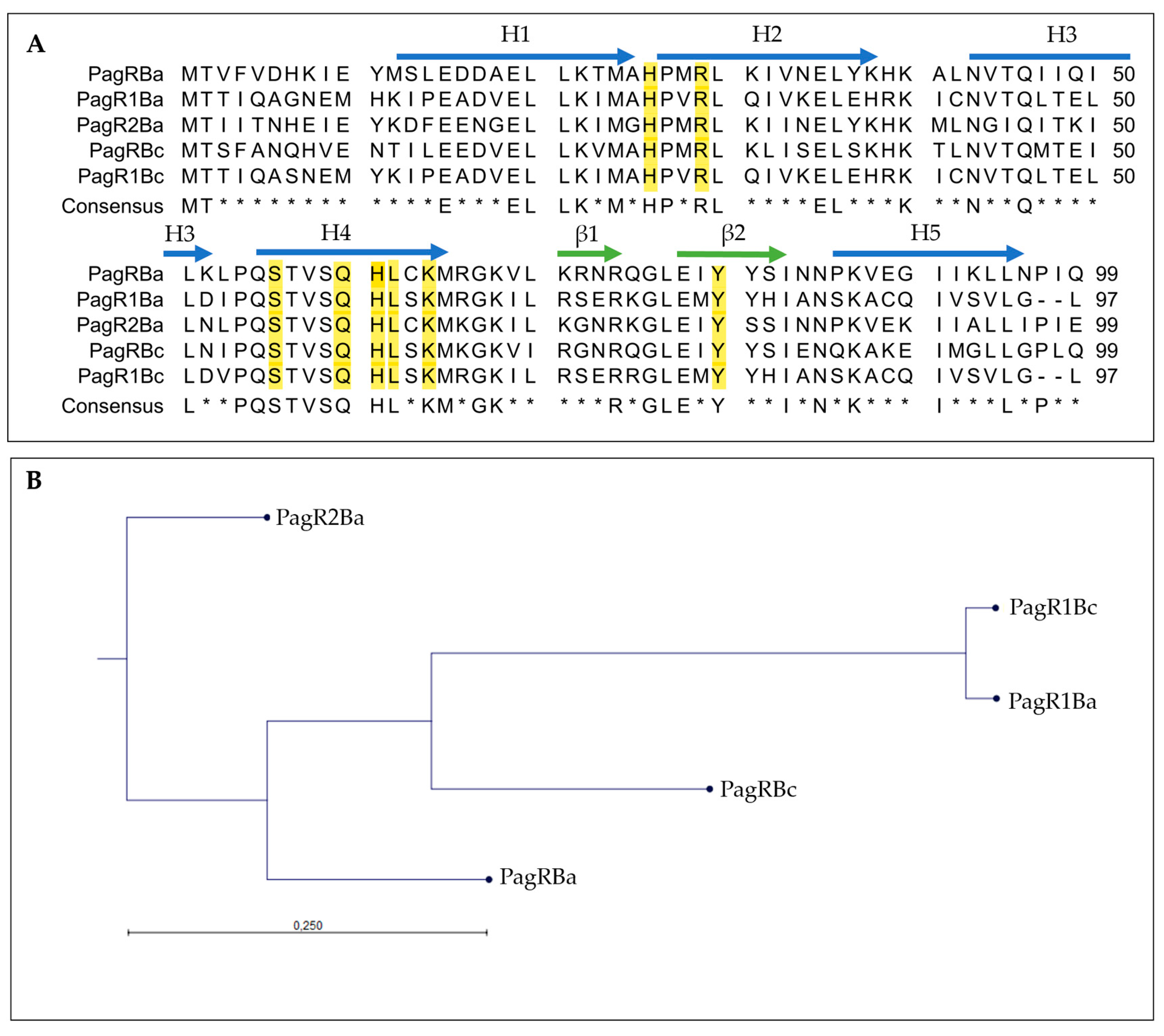
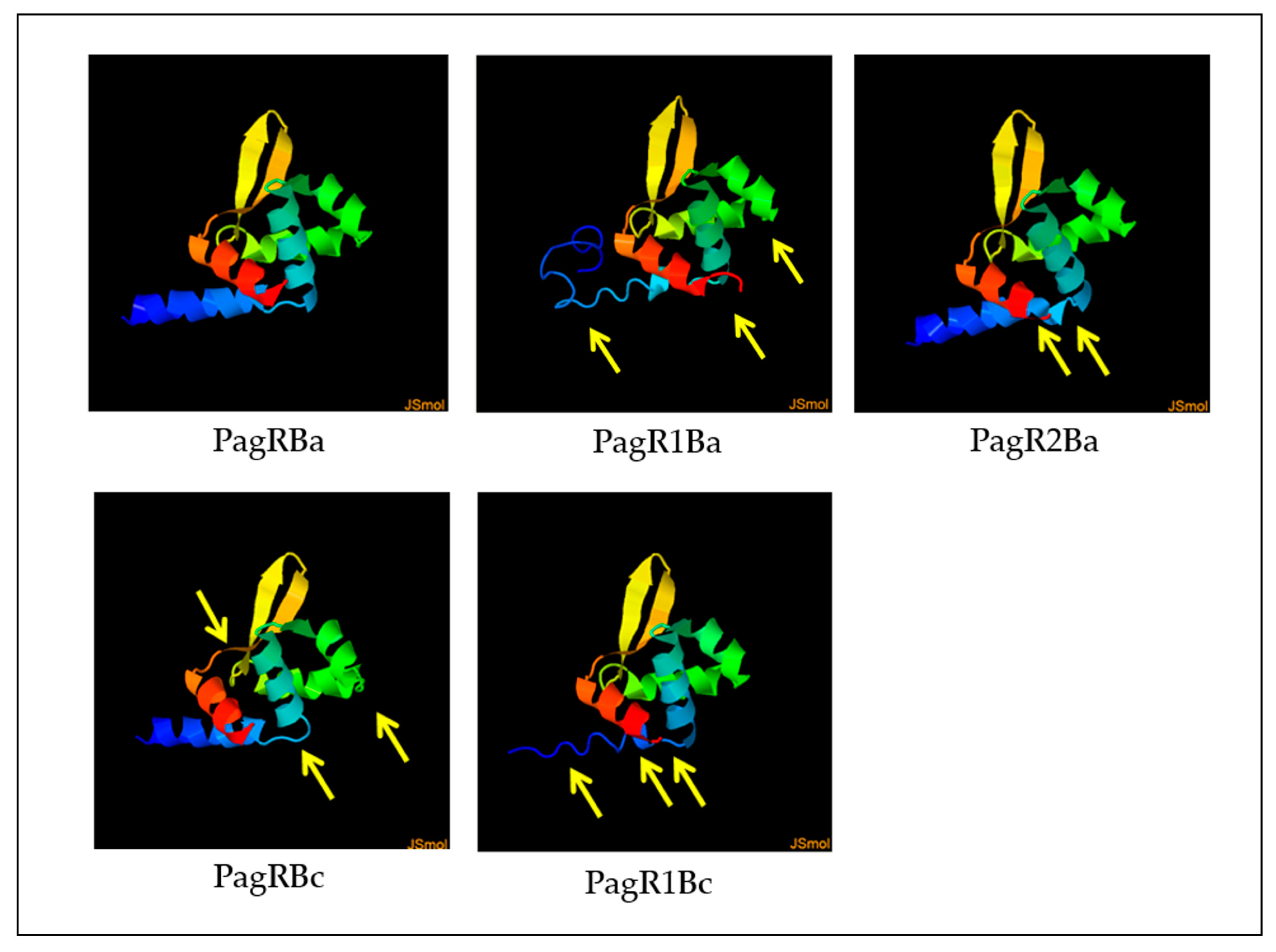

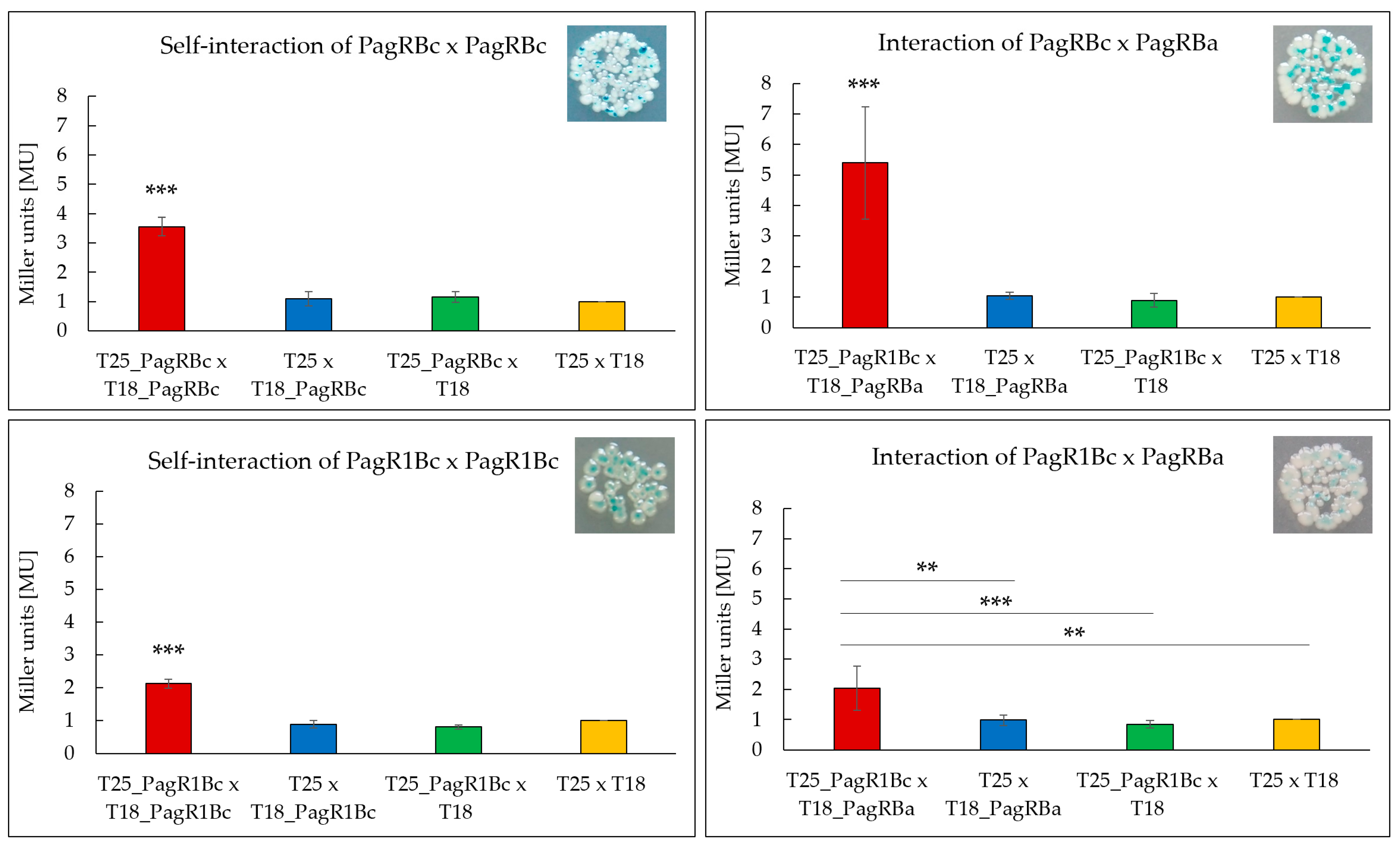
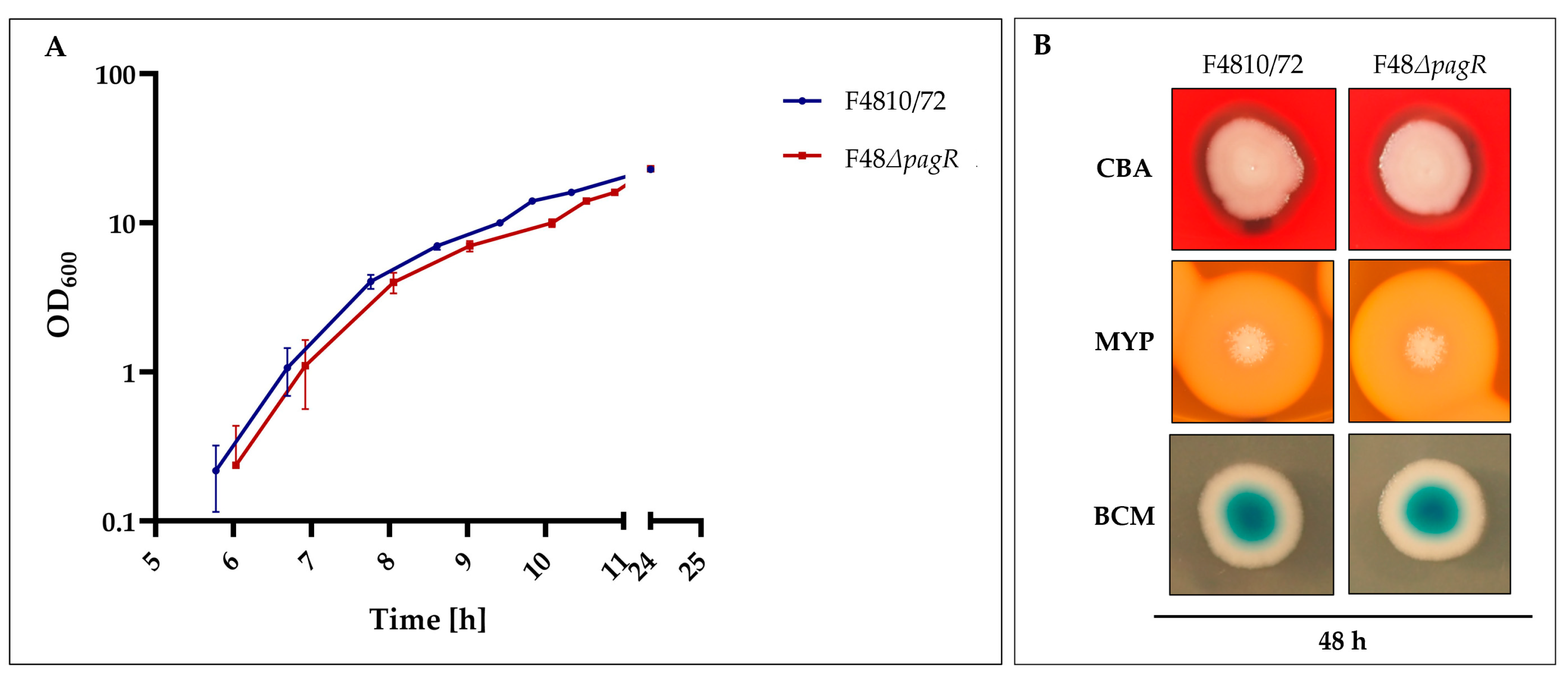

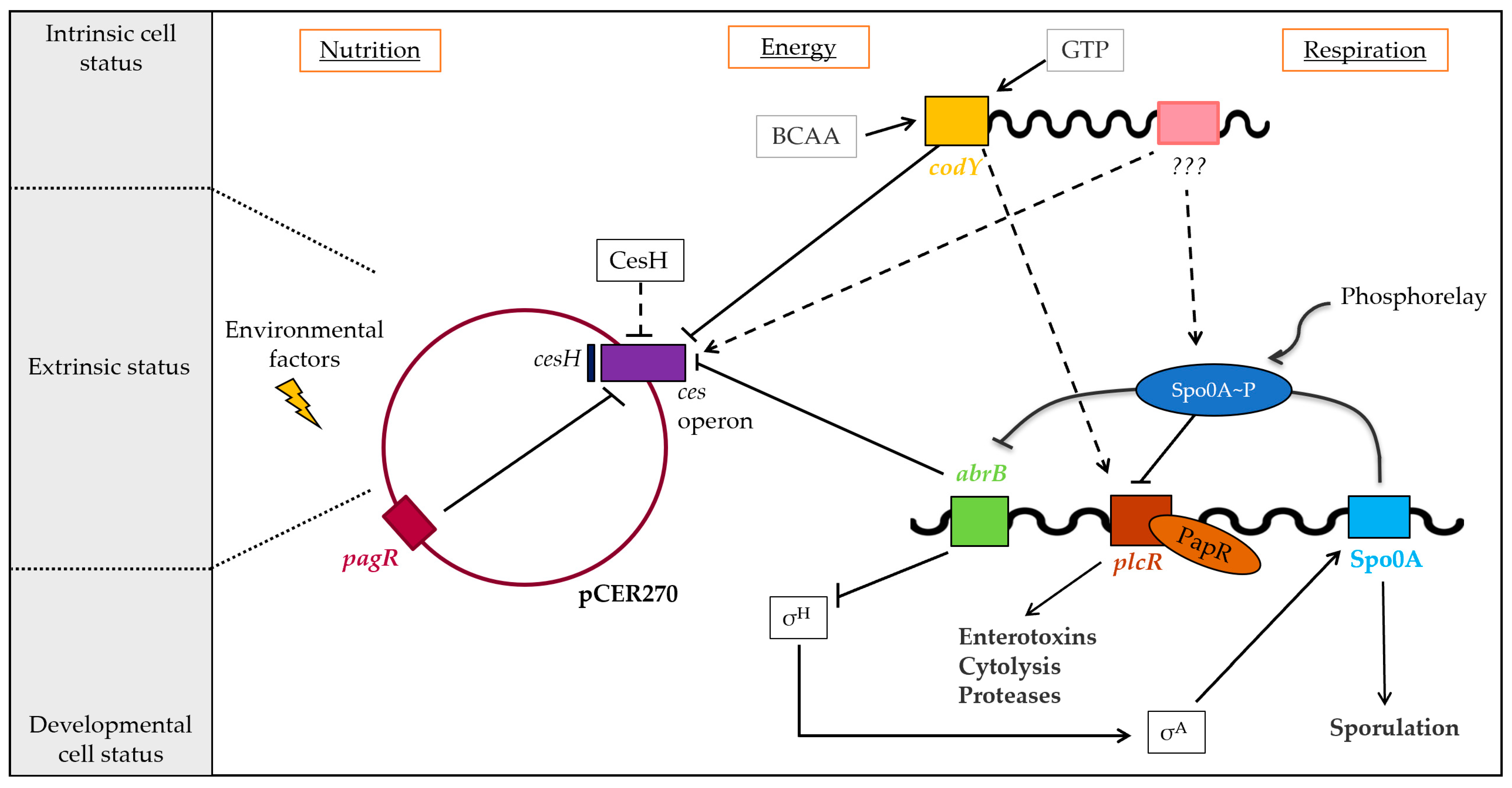
| Strain or Plasmid | Relevant Genotype or Characteristics | Reference or Source |
|---|---|---|
| E. coli | ||
| E. coli TOP 10 | General cloning host | Invitrogen |
| E. coli INV110 | Methylase-deficient cloning host | Invitrogen |
| E. coli ST18 | E. coli S17lpir ∆hemA | [43] |
| E. coli BL21(DE3) | Protein expression strain | Novagen |
| E. coli BL21 pET28b-pagRBc | Protein production strain for PagRBc used in EMSA | This study |
| E. coli BL21 pET28b-pagR1Bc | Protein production strain for PagR1Bc used in EMSA | This study |
| E. coli BL21 pET28b-pagRBa | Protein production strain for PagRBa used in EMSA | This study |
| E. coli BTH101 cya | Adenylate cyclase (cya) deficient reporter strain for bacterial two-hybrid screen (BACTH); F−, cya-99, araD139, galE15, galK16, rpsL1 (Strr), hsdR2, mcrA1, mcrB1 | Euromedex |
| B. anthracis | ||
| Sterne Strain | Vaccine strain devoid of pXO2 virulence plasmid | [44] |
| B. cereus | ||
| F4810/72 | Emetic reference strain, wild type; also termed AH187 | [45,46] |
| F48ΔpagR | F4810/72 ∆pagR::cm; cmr | This study |
| F48ΔpagR_pWHpagRBc | F48ΔpagR harboring pWH::pagR of emetic B. cereus 1 for PagRBc production, Tcr | This study |
| F48ΔpagR_pWHpagRBa | F48ΔpagR harboring pWH::pagR of B. anthracis 2 for PagRBa production, Tcr | This study |
Publisher’s Note: MDPI stays neutral with regard to jurisdictional claims in published maps and institutional affiliations. |
© 2022 by the authors. Licensee MDPI, Basel, Switzerland. This article is an open access article distributed under the terms and conditions of the Creative Commons Attribution (CC BY) license (https://creativecommons.org/licenses/by/4.0/).
Share and Cite
Kalbhenn, E.M.; Kranzler, M.; Gacek-Matthews, A.; Grass, G.; Stark, T.D.; Frenzel, E.; Ehling-Schulz, M. Impact of a Novel PagR-like Transcriptional Regulator on Cereulide Toxin Synthesis in Emetic Bacillus cereus. Int. J. Mol. Sci. 2022, 23, 11479. https://doi.org/10.3390/ijms231911479
Kalbhenn EM, Kranzler M, Gacek-Matthews A, Grass G, Stark TD, Frenzel E, Ehling-Schulz M. Impact of a Novel PagR-like Transcriptional Regulator on Cereulide Toxin Synthesis in Emetic Bacillus cereus. International Journal of Molecular Sciences. 2022; 23(19):11479. https://doi.org/10.3390/ijms231911479
Chicago/Turabian StyleKalbhenn, Eva Maria, Markus Kranzler, Agnieszka Gacek-Matthews, Gregor Grass, Timo D. Stark, Elrike Frenzel, and Monika Ehling-Schulz. 2022. "Impact of a Novel PagR-like Transcriptional Regulator on Cereulide Toxin Synthesis in Emetic Bacillus cereus" International Journal of Molecular Sciences 23, no. 19: 11479. https://doi.org/10.3390/ijms231911479
APA StyleKalbhenn, E. M., Kranzler, M., Gacek-Matthews, A., Grass, G., Stark, T. D., Frenzel, E., & Ehling-Schulz, M. (2022). Impact of a Novel PagR-like Transcriptional Regulator on Cereulide Toxin Synthesis in Emetic Bacillus cereus. International Journal of Molecular Sciences, 23(19), 11479. https://doi.org/10.3390/ijms231911479








